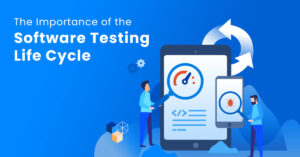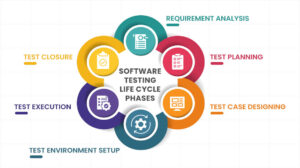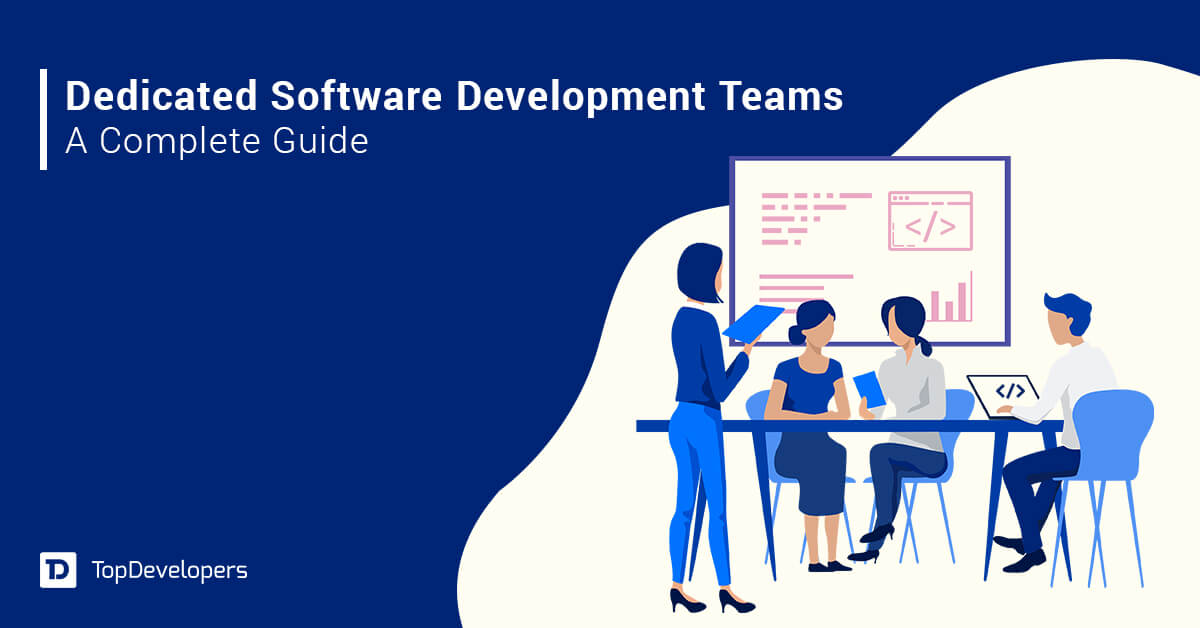
The need for the development of software is increasing at an astronomical rate to meet the digital needs of businesses and customers.
Tons of technologies and development methodologies have come and gone, and paradigms have changed, but the cardinal aspect of developing software remains the same. Make it quality-driven and make it high-performant.
Quality software is the result of intelligent efforts made by professionals to ensure that software has undergone rigorous testing to meet standard requirements, gold-plated with unique features, and is bug-free. It’s found that software development companies considered software testing as an integral part of the product development life cycle and produced better results.
Software testing ensures that software runs without failures satisfies customers, and allows businesses to achieve their target goals. It’s realized that software testing has a lifecycle of its own that must be rolled out efficiently to ensure better outcomes.
In this blog, we will walk you through the software testing life cycle (STLC), its benefits, STLC phases, and entry and exit criteria. Let’s dive into the detail of each topic.
Table of Contents
- What is the Software Testing Life Cycle (STLC)?
- SDLC Vs. STLC- clearing up the air
- What is the importance of STLC?
- What role do entry and exit criteria play in software testing?
- What are the phases of the software testing life cycle (STLC)?
- Step 1 = Requirement analysis phase of software testing
- Step 2 = Test planning phase of software testing
- Step 3 = Test case designing phase of software testing
- Step 4 = Test environment setup phase of software testing
- Step 5 = Test execution phase of software testing
- Step 6 = Test closure phase of software testing
- Does STLC well-suited to agile development?
- STLC is a solution to flawless development
What is the Software Testing Life Cycle (STLC)?
The software testing life cycle, also known as STLC, involves executing a series of tests during software development to ensure it
- Meets the minimum quality requirements
- Identifies defects and fixes them
- Performs as expected
- Implementation of a specific feature
- Verifies and validates that the software is perfect in all aspects with 360-degree testing
SDLC Vs. STLC- clearing up the air
SDLC (Software Development Life Cycle) refers to a journey of shaping an idea into full-fledged software that includes various phases, wherein STLC (Software Testing Life Cycle) is just a part of the software development process.
STLC is a child of SDLC that puts a laser focus on software testing while understanding the software requirements. The work of STLC after the development phase completion so that bugs are identified and reported as the software development progresses, which helps in fixing them proactively.
All in all, the role of STLC is to find out whether the part of the software developed is working as expected or not and then inform the same to the team of necessary actions.
What is the importance of STLC?
The role of STLC illustrated that it’s imperative and cannot be skipped at any cost. The benefits highlight the importance of the testing phase in the software development process.
Shift-left testing
With a clear understanding of project scope, time constraint, and goals, the STLC process helps the team to track the inefficiencies, bugs, or other issues that helps in increasing the overall efficiency of the software. Also, the newly built features are implemented in the software only after sufficient testing.
Speedy bug detection
Testing the software as it’s developed enables software developers to fix the issues on an ongoing basis. Otherwise, fixing them after the project development is completed doubles up their effort and proves to be expensive for you.
Quality assurance
Quality delivery assured with the Software Testing process helps in gaining the customer confidence in the business software. Also, well-developed software incurs reduced maintenance cost that ultimately mitigates the development cost of the application.
Delight customers
Customers won’t take a second to stop using software that has bugs, is unstable, or perform poorly. The process of software testing life cycle helps in avoiding all situations and staying in the business.
What role do entry and exit criteria play in software testing?
We have seen the entry and exit criteria in all phases of the software testing life cycle that plays a vital role in making the phases completed within the stipulated time. Let’s understand them in brief.
Entry criteria in Software Testing
Entry criteria define which things the testing team must have before starting a certain phase of testing. The team must verify whether they have everything beforehand from conditions to ongoing activities. For instance, test environment setup first requires test case development and designing as entry criteria before the team begins with the test case environment.
Exit criteria of Software Testing
Exit criteria determine the requirements and actions that need to be completed as the specific testing phase ends. The team must check if all the results are derived at the end of that testing phase or not to ensure the completion of the test phase. For instance, the test case execution phase end is marked by the bug report sharing to the development team.
What are the phases of the software testing life cycle (STLC)?
The software testing life cycle involves 6 phases, wherein each phase mandatorily has entry and exit criteria that define the beginning and the ending of each phase. Let’s take a look at all of them.
Step 1 = Requirement analysis phase of software testing
In the first step of STLC, QA and testing team figure out what needs to be tested in the project from a testing point of view. The testing requirements of software applications are understood by the QA team through close collaboration with business analysts, technical leads, system architects, clients, and other stakeholders. Different software testing requirements that are analyzed include-
- Business requirement: High-level needs of business from the software solution are extracted from the business case.
- Architectural & design requirements: The requirements of software architecture and design are discussed and analyzed in detail to get business needs met through software development projects.
- System & integration requirement: The extensive detail of all the moving parts of the system and third-party integrations are analyzed before software programmers start coding.
The procedure of STLC helps to close the gap between what’s expected and what’s delivered with the help of the requirement analysis done in the software development process.
Entry criteria: The portion of the software project needs to be tested along with the specification gets available.
Exit criteria: With a good understanding of the project requirements, the testable requirements list gets ready.
Step 2 = Test planning phase of software testing
At this stage, all the testing strategies are defined along with cost and effort estimation. With the involvement of the testing manager, different types of testing used for the project are defined. Such as
- Unit testing
- API testing
- Integration testing
- System testing
- Agile testing
- Install/uninstall testing
After the selection of the software testing type, the test plan creation process is started and includes steps-
- Product analysis
- Test strategy designing
- Test objective defining
- Test criteria defining
- Resources planning
- Test environment planning
- Scheduling
- Test deliverable determination
Entry criteria: The test strategy is planned and reported before it’s rolled out.
Exit criteria: When the test strategy is approved by the key stakeholders.
Step 3 = Test case designing phase of software testing
Post-test planning, the testers head on to designing and developing test cases that cover almost all the possible cases for all the functionalities of the software products to test. Testers can self-prioritize the test cases based on the effective results they produce. Later, the features are verified and validated followed by a review and updation of the test cases.
Mainly, different test conditions are tried with input data and anticipated outcomes. In a nutshell, test case designing includes- researching possible actions on software functionalities, test case creation, test case prioritization, and automated script preparation for test cases.
Entry criteria: The test plan is shaped into test cases
Exit criteria: Prepared test cases verified to bring expected outcomes.
Step 4 = Test environment setup phase of software testing
When test cases are ready, it’s time to configure and deploy the test environment using open-source frameworks such as Flutter or Appium so that it’s ensured that software runs impeccably in distinct test environments. For instance, some features may not work in internet explorer but perform amazingly in Google Chrome.
Mainly, this stage of STLC involves
- Understanding user requirements
- Knowing hardware/software/server requirements for different performance levels
- Researching the test environment
- Prioritizing the test environment
- Performing smoke testing on setting up test environments
Entry criteria: Ready test plan with project architecture and system design defined.
Exit criteria: The test environment is set up and checked.
Step 5 = Test execution phase of software testing
This STLC phase enables the juices to flow, wherein testers view the result of test cases created according to the testing strategy plan. Test case execution helps in identifying, logging, and then reporting the bugs in the software system. The testing also needs to document the variation in expected results so that differences are fixed by the dedicated development team.
When the team of software developers fixes the bug, again, regression testing is performed to ensure the deployment of change making the software perform as expected. Leveraging automated tools or scripts is good to perform tests repetitively.
Entry criteria: Ready test cases and approved test environment.
Exit criteria: A test case execution report with defects is sent to the development team.
Step 6 = Test closure phase of software testing
This stage of the software testing life cycle marks the end of the test execution where the Quality Assurance team sits together to check the results and discuss what doesn’t go as expected. The team discusses everything from software quality and test coverage to cost to analyze what brings deviation from the expected results.
While testing the software product this phase should not be skipped because it highlights the issues that popped up during testing, defects in strategies, and approaches for bringing effective results than before.
Entry criteria: Test case execution report is shared.
Exit criteria: Approved test reporting along with which steps to be taken next.
Does STLC well-suited to agile development?
Agile development has become a way of development in the dynamic IT landscape where iterations are common to step in with the market changes and evolving customer preferences. Agile adoption enables businesses to get built quality software at speed thereby busting software development myths such as QA is not essential, speedy delivery requires big teams and more.
STLC in agile software development helps the development team and testing team to seamlessly communicate and collaborate for the changes so that everything will remain on track and requirements are met. Following the process of STLC properly helps the team to better manage change and risks.
When you hire software developers, you should follow the best practices and ask a couple of questions such as the STLC model, agile development methodology, and more to get the right team at your disposal.
STLC is a solution to flawless development
The errors, bugs, or performance issues identification at the end of the development process is not the only purpose of testing to ensure high-performant software delivery. Instead, testing at the end of the development phase doubles up the time and effort investment by a large fraction.
STLC- Software Testing Life Cycle eases the testing resources. Quick bug fixing- the by-product of STLC improves product quality and enhances customer satisfaction which ultimately enables brands to leapfrog the competition. During software development outsourcing, you should ask for beta testing with STLC before getting deliverables to mitigate the bugs and crashes, and more.
Realizing the importance of STLC, a guide from experts is created that highlights its overview, its benefits, and different phases followed by entry and exit criteria. Ask the software development company regarding the STLC process before you partner with them to ensure quality, timely and faster delivery.
STLC-related questions that business owners should ask
What is the software testing life cycle?
STLC means Software Testing Life Cycle Its a series of tasks intended to assess the condition of a system and offer suggestions for improvement. Also, different phases in which software testing is performed helps to launch the quality software product.
Why is the software testing life cycle so important?
Software testing plays a vital role in faster and quality delivery of reliable software, which, in turn, mitigates development cost and delight the customers as well.
What are entry and exit criteria in STLC?
The research and development process mostly includes entry and exit criteria wherein every process must meet these criteria before starting and moving to the next phase. For instance, Entry criteria depict what should tester have before starting the phase and Exit criteria depict what should tester have before ending the phase.
What are the phases of the testing life cycle?
The software testing life cycle process includes six phases-
- Requirement analysis
- Test planning
- Test case designing
- Test environment setup
- Test execution
- Test closure
What are the Basic characteristics of STLC?
STLC consists of testing phase of SDLC that starts as the software development requirements are shared by the business clients. The fundamental part of Software testing Life Cycle that moves ahead in a step-by-step manner ensures that the quality is achieved without bugs and the product has all the mentioned features and functionalities that are fully functional and user-friendly.
 Avantika Shergil
| Jan 4, 2023
Avantika Shergil
| Jan 4, 2023
Avantika Shergil is a technology enthusiast and thought leader with deep expertise in software development and web technologies. With over 8 years of experience analyzing and evaluating cutting-edge digital solutions, Avantika has a knack for demystifying complex tech trends. Her insights into modern programming frameworks, system architecture, and web innovation have empowered businesses to make informed decisions in the ever-evolving tech landscape. Avantika is passionate about bridging the gap between technology and business strategy, helping businesses build customized software and website, and understand about different tools to leverage effectively for their ventures. Explore her work for a unique perspective on the future of digital innovation.







